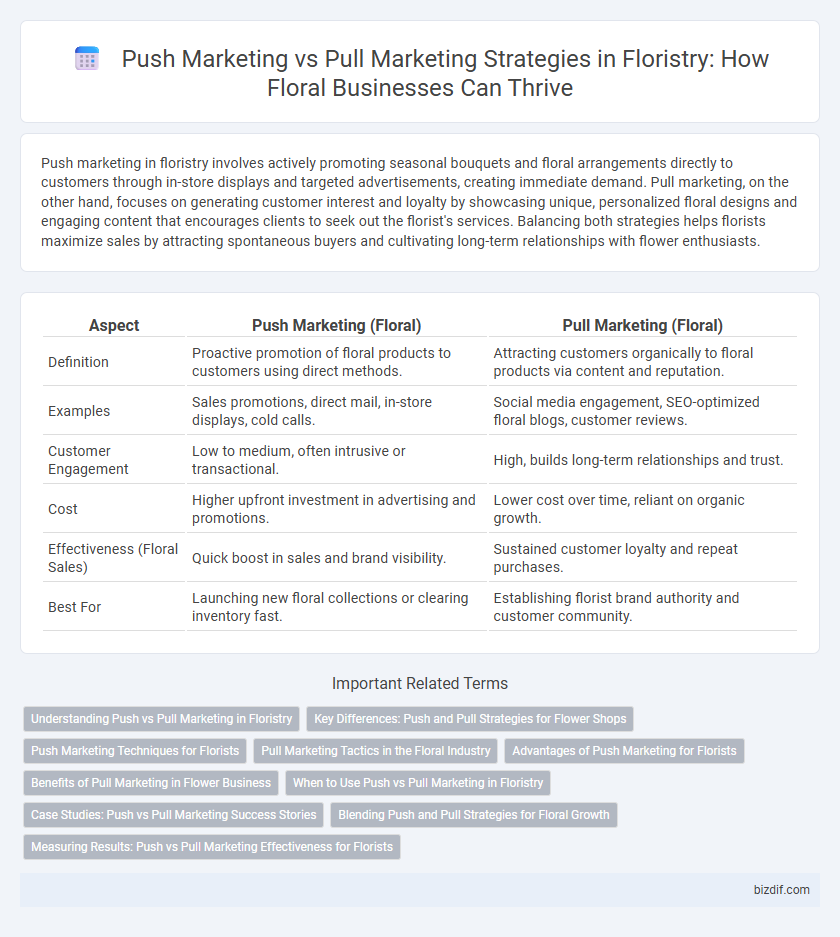Push marketing in floristry involves actively promoting seasonal bouquets and floral arrangements directly to customers through in-store displays and targeted advertisements, creating immediate demand. Pull marketing, on the other hand, focuses on generating customer interest and loyalty by showcasing unique, personalized floral designs and engaging content that encourages clients to seek out the florist's services. Balancing both strategies helps florists maximize sales by attracting spontaneous buyers and cultivating long-term relationships with flower enthusiasts.
Table of Comparison
| Aspect | Push Marketing (Floral) | Pull Marketing (Floral) |
|---|---|---|
| Definition | Proactive promotion of floral products to customers using direct methods. | Attracting customers organically to floral products via content and reputation. |
| Examples | Sales promotions, direct mail, in-store displays, cold calls. | Social media engagement, SEO-optimized floral blogs, customer reviews. |
| Customer Engagement | Low to medium, often intrusive or transactional. | High, builds long-term relationships and trust. |
| Cost | Higher upfront investment in advertising and promotions. | Lower cost over time, reliant on organic growth. |
| Effectiveness (Floral Sales) | Quick boost in sales and brand visibility. | Sustained customer loyalty and repeat purchases. |
| Best For | Launching new floral collections or clearing inventory fast. | Establishing florist brand authority and customer community. |
Understanding Push vs Pull Marketing in Floristry
Push marketing in floristry involves proactively promoting floral products to retailers and customers through direct sales, displays, and promotions, aiming to increase immediate demand. Pull marketing focuses on creating customer demand through branding, social media engagement, and content marketing to encourage consumers to seek out specific florists or floral arrangements. Understanding these strategies helps florists balance inventory, optimize marketing spend, and enhance customer loyalty in a competitive floral market.
Key Differences: Push and Pull Strategies for Flower Shops
Push marketing in floristry involves actively promoting floral products through direct advertising, in-store displays, and sales promotions to stimulate immediate demand among customers. Pull marketing, conversely, focuses on creating consumer interest and loyalty through content marketing, social media engagement, and brand reputation to attract customers to flower shops over time. Key differences include push strategies targeting immediate sales boosts, while pull strategies aim to build long-term customer relationships and sustainable demand for floral arrangements.
Push Marketing Techniques for Florists
Push marketing techniques for florists involve actively promoting floral products directly to customers through channels such as in-store displays, email newsletters, and targeted social media ads. Utilizing seasonal promotions, limited-time offers, and partnerships with event planners enhances product visibility and drives immediate sales. Effective push strategies also include personalized customer outreach and leveraging local market trends to boost floral arrangements' appeal.
Pull Marketing Tactics in the Floral Industry
Pull marketing tactics in the floral industry prioritize customer engagement by leveraging social media platforms, SEO-optimized content, and email marketing campaigns to attract and retain flower buyers. Floral businesses build brand loyalty through personalized recommendations, seasonal promotions, and interactive online experiences that encourage repeat purchases. These strategies drive organic traffic and enhance customer relationships, ultimately increasing sales without aggressive sales pitches.
Advantages of Push Marketing for Florists
Push marketing for florists drives immediate sales by actively promoting floral arrangements through targeted advertising and in-store displays, capturing customers' attention at the point of purchase. This strategy ensures high product visibility, encouraging impulse buys and boosting short-term revenue, especially during peak seasons like Valentine's Day and Mother's Day. Florists benefit from better inventory control by pushing specific arrangements, reducing waste and optimizing stock turnover.
Benefits of Pull Marketing in Flower Business
Pull marketing in the flower business attracts customers by creating strong brand awareness and engaging content that inspires purchases, leading to higher customer loyalty and repeat sales. By leveraging social media campaigns, floral blogs, and search engine optimization, florists can generate organic demand that enhances long-term profitability. This strategy reduces reliance on aggressive promotions and helps build a sustainable customer base seeking specific floral arrangements and seasonal bouquets.
When to Use Push vs Pull Marketing in Floristry
Push marketing in floristry is effective during peak seasons like Valentine's Day and Mother's Day when florists actively promote fresh bouquets to retailers or direct customers to drive immediate sales. Pull marketing strategies suit year-round brand-building efforts, encouraging customers to seek out a florist's unique floral designs through social media and content marketing. Choosing push marketing during high-demand periods ensures inventory turnover, while pull marketing cultivates customer loyalty and sustained interest in specialized floral arrangements.
Case Studies: Push vs Pull Marketing Success Stories
Case studies in floristry demonstrate that push marketing campaigns, such as targeted email promotions and in-store floral displays, effectively boost immediate sales by creating demand at point-of-purchase. Pull marketing strategies, including engaging social media content and influencer partnerships, build long-term brand loyalty by attracting customers organically to the floral business. Successful florists often combine push tactics for seasonal bouquets with pull marketing through storytelling and educational content to maximize customer engagement and retention.
Blending Push and Pull Strategies for Floral Growth
Blending push and pull marketing strategies in floristry maximizes customer reach and engagement by combining proactive promotions with demand-driven approaches. Push tactics, like in-store floral displays and direct sales, stimulate immediate purchases, while pull methods, such as social media campaigns and loyalty programs, attract and retain customers by building brand affinity. Integrating these strategies enhances floral business growth by balancing supply-driven outreach with customer-driven interest and repeat sales.
Measuring Results: Push vs Pull Marketing Effectiveness for Florists
Measuring results in floristry marketing reveals push strategies, such as direct promotions and in-store displays, drive immediate sales spikes by targeting customer impulse purchases. Pull marketing, leveraging SEO and social media content, builds long-term brand awareness and customer loyalty by attracting clients actively seeking floral services. Analyzing metrics like conversion rates, customer retention, and engagement distinguishes push's short-term impact from pull's sustained growth in florist marketing effectiveness.
Push marketing vs pull marketing (floral) Infographic

 bizdif.com
bizdif.com